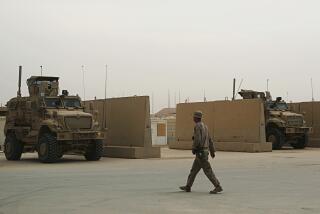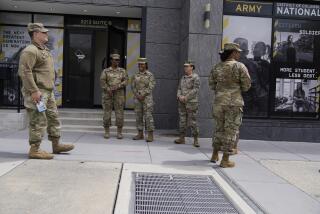No choice -- withdrawal starts in ’08
In his testimony to Congress on Monday, Gen. David H. Petraeus announced that he was withdrawing the first “surge” troops from Iraq this month and recommended bringing home the first combat brigade in December, followed by an additional four brigades over the following eight months. But he postponed any decision about the baseline force of 130,000 troops until next March.
In making his case for withdrawal, Petraeus cited improvements in Iraqi security forces, cooperation by Sunni sheiks in Anbar province and successes against extremists and Al Qaeda operatives in Iraq. Legislators who challenged his comments, as well as those who supported him, focused on these strategic variables in Iraq.
What all of this debate about withdrawal missed, however, is that the driver is not conditions in Iraq or politics in the United States but the hard realities of Army and Marine Corps readiness. As the troops’ extended 15-month tours of duty end, the Army and Marine Corps simply don’t have more troops to replace them. The withdrawal will be, in effect, the flip side of the surge.
This “drawdown” should come as no surprise. Army Gen. John P. Abizaid, the former head of the U.S. Central Command for forces in the Middle East, candidly prepared us for this when he was questioned about the surge by the Senate Armed Services Committee last fall. “We can put in 20,000 more Americans tomorrow and achieve a temporary effect,” he said. “But when you look at the overall American force pool that’s available, the ability to sustain that commitment is simply not something that we have right now with the size of the Army and the Marine Corps.”
How is it possible that a nation with 300 million people, a $13 trillion GDP and a defense budget of more than $600 billion is unable to muster 30,000 additional troops and sustain the surge for even a full year? The bottom line is that the leaders responsible for our military -- the president, the secretary of Defense and Congress -- refused over the past six years (as their predecessors had before them) to recruit, train and equip more troops. Even after deciding to attack Iraq, this leadership neglected its duty to raise the forces required, until it was too late to affect the outcome.
The reasons are varied and complicated. Illusions of a short war of liberation in Iraq, and a stubborn unwillingness to recognize the growing insurgency, blinded many political leaders. A command system that divides responsibility for planning operations from responsibility for generating forces has produced untenable plans and dangerous underestimates of resources. Absent a formal declaration of war, the president had to declare a partial, rather than a full, mobilization of our military following 9/11, effectively limiting access to thousands of National Guard and Reserve personnel.
Some steps are being taken to address these problems, such as the congressionally mandated study of the role of the Reserves and National Guard and how they are mobilized. The president and Congress also have authorized the active Army and Marine Corps to grow by 57,000 troops, but that will take time.
We should also take a hard look at the relationship among the branches of the armed services, combatant commands and the Joint Staff. When fights were localized and small, it was manageable to have combatant commanders and service chiefs reporting directly and separately to the secretary of Defense. But when we are in a global fight, it would be more effective to have the chairman of the Joint Chiefs of Staff consolidating these aspects of war fighting and making operational decisions -- so that battlefield planning and strategies better match resource decisions, and vice versa.
Whatever the successes and failures of the surge, troop withdrawal is unavoidable in Iraq now. As the forces and the commanders there struggle to find a workable way to accomplish our goals amid that reality, we can support them best by expanding and restructuring our military so that future decisions about lengthy, complex fights can be made on the strategic merits, without capricious constraints.
Graham Allison is director of the Belfer Center for Science and International Affairs at Harvard’s Kennedy School of Government and a former assistant secretary of Defense. Retired Brig. Gen. Kevin Ryan is a senior fellow at the Belfer Center.
More to Read
A cure for the common opinion
Get thought-provoking perspectives with our weekly newsletter.
You may occasionally receive promotional content from the Los Angeles Times.










